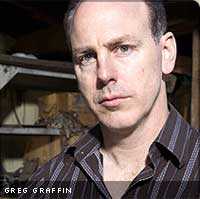Even though I am known as a punk rock singer and songwriter, a world apart from old-time music, the roots of my singing go back to my Wisconsin childhood and family gatherings in Indiana. For most of my life, the old-time music of rural America has served as one of the soundtracks to my life and daily routines.
My earliest musical memory is from when I was four or five and my Mom's brother, Uncle Stanley, the son of a teacher and a General Motors assembly-line worker in Anderson, Indiana, gathered all us cousins together for a sing-along. Me, Lem Briggs, and Ol' Bill Brown took a load of corn to town were the first words to a song called Kickin' my Dog Around, and we laughed and sang as our parents joined in with Uncle Stanley's guitar or banjo.
Over the years the repertoire grew at family gatherings while at the same time I became known to the outside world as the singer of Bad Religion. Some of the earliest reviews of my singing with BR mention the folksy sound of my delivery. Since then, Bad Religion has continued to record highly charged punk rock, yet most all our songs can be strummed on an acoustic guitar and sung without amplification like an old-time folk traditional.
During BR sessions, my songwriting partner Brett Gurewitz and I would pass the acoustic guitar back and forth sharing ideas that later we would present to the rest of the band. One day, during a break from rehearsals for the album The Process of Belief, Brett heard me playing an old standard Omie Wise, and he suggested that we record an album of old-time music. On that day, the seeds of this solo project were planted.
Cold as the Clay is the culmination of Brett's production concept: an honestly recorded array of highly talented musicians playing some new songs I've written as well as a number of traditional songs that helped form the 18th and 19th century American cultural landscape. The modern songs are inspired by my love of country rock in the vein of Gram Parsons, The Band, and Neil Young; all of which have, at one time or another, influenced BR songs. The traditional arrangements are faithful reproductions of the styles and instrumentation found on early recordings.
Lyrically, I tried to depict timeless snapshots of American life, just as the enduring old-time songs we continue to sing today weave pastoral ideals into our modern-day complexity. Musically, the album mimics the bimodal dissonance of American life: half of it comes creaking from podunk towns and untrammeled byways, and the other half is brimming with modern fidelity.
I couldn't have wished for a better cast of accompanying musicians. Electric guitars were played by Stephen Carroll, bass guitar, Greg Smith, and Jason Tait played drums. Together, these guys comprise three-fourths of a band called the Weakerthans, who create some of the best music I've ever come across. For harmonies and a vocal duet on an old-time song called Talk About Suffering I was privileged to be joined by the incomparable Jolie Holland. Equally talented and versatile are the old-time musicians I was privileged to play with, including Joe Wack (guitar), Chris Berry (guitar and banjo), and David Bragger (fiddle, banjo, and mandolin). David grew up as my next-door neighbor in Los Angeles and was just an eight-year-old kid when he used to watch BR rehearsals in my mom's garage. Now he's one of the finest old-time musicians in L.A.
The album was recorded and mixed in seven days. It is a testament to the incredible skill of the musicians and to Brett's vision as a producer. Brett wanted to capture authenticity, so he asked the old-time musicians how they usually arrange themselves. Knee to knee in a circle was the reply. So that's how they sat, with one microphone in the center of the circle, utilizing physical positioning to achieve the blend of sounds. A couple of strategically placed room-microphones created some spatial complement and the result is a vivid, hi-fi recording that makes you feel as if you are in a 19th century pine-floored cabin or village-church with the musicians right there next to you.
Recording the electric instruments proved equally intimate since Brett's idea was to use minimum circuitry and maximum spontaneity. The title track was recorded on the third take, just one hour after I taught the chords to the rest of the musicians. On the vocal track you can hear me guiding the band toward the end of the song, two more, last one. The album is full of these spontaneous moments but we never had to worry about compromises. The instrumentation is masterfully executed on every track.
We set out create a record that would honor the legacy of American music, and it is my hope that we were able to capture a lasting musical moment. I wanted to show how my work with Bad Religion was informed by other, seemingly disparate and unconventional genres of music that at first glance may appear to have nothing to do with punk. My hope is that this project will live to pass along the tradition of American songwriting to others long after I am buried and cold as the clay.
